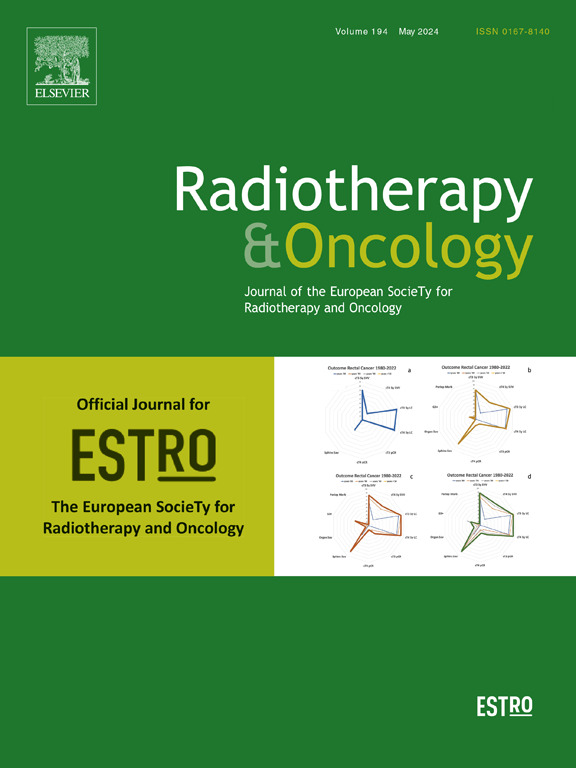Efficacy of radiotherapy for bone metastasis in breast cancer patients treated with cyclin-dependent kinase 4/6 inhibitors
IF 4.9
1区 医学
Q1 ONCOLOGY
引用次数: 0
Abstract
Background
In patients diagnosed with estrogen receptor (ER)-positive, human epidermal growth factor receptor 2 (HER2)-negative advanced breast cancer, bone metastases emerge as the primary site of significant tumor burden. Cyclin-dependent kinase 4/6 (CDK4/6i) inhibitors are the gold standard in this clinical scenario, while radiotherapy (RT) represents a valuable addition. However, data on the efficacy of this combination remain scarce. We aimed to evaluate efficacy of RT in bone metastatic breast cancer patients treated with CDK4/6 inhibitors.
Materials and methods
398 patients (pts) with ER-positive HER2-negative breast cancer with bone metastases treated with CDK4/6i between 2018–2024 were analyzed. A total of 114 pts received 177 bone RT concurrently with CDK4/6i or within 6 months before CDK4/6i initiation, including 34 courses of stereotactic-body RT and 143 courses of conventional RT.
Results
The median progression-free survival (PFS) in pts who received bone RT was 31.0 months, compared to 26.3 months in pts without bone RT. The 2-y PFS for pts with bone RT was 57.1 % [95 % CI: 46.3–66.6 %] vs. 53.2 % [95 % CI: 46.3–59.6 %] for patients without bone RT (p = 0.51). The median overall survival (OS) for pts who received bone RT was 49.1 months, compared to 40.5 months for pts without bone RT. The 3-y OS for pts with bone RT was 63.7 % [95 % CI: 51.5–73.5 %] vs. 55.0 % [95 % CI 46.6–62.6 %] for pts without bone RT (p = 0.50). The 3-y local control for irradiated patients was 86.9 % [95 % CI 72.2–94.1 %].
Conclusions
In this study, we present the largest cohort published to date of breast cancer patients who received CDK4/6i alongside bone-directed RT. Although the observed differences in survival were not statistically significant, RT remains a viable treatment modality in metastatic breast cancer in some patients.
使用细胞周期蛋白依赖性激酶 4/6 抑制剂治疗乳腺癌患者骨转移的放疗疗效。
背景:在确诊为雌激素受体(ER)阳性、人表皮生长因子受体 2(HER2)阴性的晚期乳腺癌患者中,骨转移成为肿瘤负担的主要部位。细胞周期蛋白依赖性激酶 4/6(CDK4/6i)抑制剂是这种临床情况下的金标准,而放射治疗(RT)则是一种有价值的补充。然而,有关这种联合疗法疗效的数据仍然很少。我们旨在评估RT在接受CDK4/6抑制剂治疗的骨转移乳腺癌患者中的疗效。材料和方法:分析了2018-2024年间接受CDK4/6i治疗的398例ER阳性HER2阴性骨转移乳腺癌患者(pts)。共有114名pts在CDK4/6i同时或CDK4/6i开始前6个月内接受了177次骨RT,包括34个疗程的立体定向体外RT和143个疗程的常规RT.结果:接受骨RT治疗的患者的中位无进展生存期(PFS)为31.0个月,而未接受骨RT治疗的患者为26.3个月。接受骨RT治疗的患者的2年无进展生存期为57.1% [95 % CI: 46.3-66.6%],而未接受骨RT治疗的患者为53.2% [95 % CI: 46.3-59.6%](P = 0.51)。接受骨RT治疗的患者的中位总生存期(OS)为49.1个月,而未接受骨RT治疗的患者为40.5个月。接受骨RT治疗的患者的3年生存率为63.7% [95 % CI: 51.5-73.5%],而未接受骨RT治疗的患者的3年生存率为55.0% [95 % CI 46.6-62.6%](P = 0.50)。接受放射治疗的患者 3 年的局部控制率为 86.9% [95 % CI 72.2-94.1%]:在这项研究中,我们展示了迄今为止发表的规模最大的乳腺癌患者队列,这些患者在接受骨定向 RT 的同时还接受了 CDK4/6i。虽然观察到的生存率差异在统计学上并不显著,但对于某些转移性乳腺癌患者来说,RT仍是一种可行的治疗方式。
本文章由计算机程序翻译,如有差异,请以英文原文为准。
求助全文
约1分钟内获得全文
求助全文
来源期刊

Radiotherapy and Oncology
医学-核医学
CiteScore
10.30
自引率
10.50%
发文量
2445
审稿时长
45 days
期刊介绍:
Radiotherapy and Oncology publishes papers describing original research as well as review articles. It covers areas of interest relating to radiation oncology. This includes: clinical radiotherapy, combined modality treatment, translational studies, epidemiological outcomes, imaging, dosimetry, and radiation therapy planning, experimental work in radiobiology, chemobiology, hyperthermia and tumour biology, as well as data science in radiation oncology and physics aspects relevant to oncology.Papers on more general aspects of interest to the radiation oncologist including chemotherapy, surgery and immunology are also published.
 求助内容:
求助内容: 应助结果提醒方式:
应助结果提醒方式:


